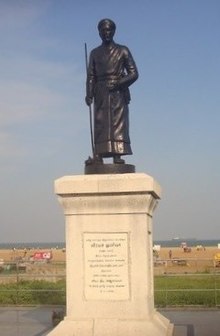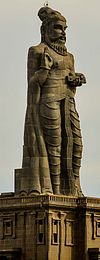| This article includes a list of general references, but it lacks sufficient corresponding inline citations. Please help to improve this article by introducing more precise citations. (January 2008) (Learn how and when to remove this message) |
| Constantine Joseph Beschi | |
|---|---|
 Veeramamunivar statue at the Marina Beach, Chennai Veeramamunivar statue at the Marina Beach, Chennai | |
| Born | 8 November 1680 Castiglione delle Stiviere, Duchy of Mantua |
| Died | 4 February 1747, Kingdom of Cochin, Ambalakkaru, India or Manapad, Tamilnadu, India |
| Resting place | Sampaloor, Kerala or Manapad, Tamilnadu |
| Other names | வீரமாமுனிவர் (Veeramamunivar) |
Constantine Joseph Beschi (8 November 1680 – 4 February 1747), also known under his Tamil name of Vīramāmunivar, was an Italian Jesuit priest, missionary in South India, and Tamil language littérateur.
Early years
Born in Castiglione delle Stiviere, in the district of Mantua, in Italy, on 8 November 1680, Beschi got his secondary education in the Jesuits' High School at Mantua, which taught rhetoric, humanities and grammar. After becoming a Jesuit in 1698, he was trained in Ravenna and Bologna, studying philosophy for three years from 1701–1703 in Bologna, and theology for four years from 1706–1710. His studies also included Latin, French, Portuguese, Greek, and Hebrew. He was ordained as a priest in 1709. On hearing about the work done in India by the Jesuits returning to Italy from India, Beschi was eager to come to India. He requested and obtained permission from Superior General Michelangelo Tamburini to be sent to the Jesuit mission at Madurai in South India. Sailing from Lisbon he reached Goa in October 1710, from where he proceeded immediately to South India. He arrived in Madurai in May 1711.
In South India
Inspired by what was done in China, Beschi adopted the native Tamilians' lifestyle in his life and in his missionary work. For example, he adopted the saffron coloured robe generally worn by a sannyasi (Indian ascetic). He visited several important centres such as Tirunelveli, Ramanathapuram, Thanjavur and, of course, Madurai to learn the Tamil language. He also studied Sanskrit and Telugu. He met with persecution in 1714–15 and escaped a death sentence. This gave him more time to master the Tamil language in which he soon showed great proficiency.Because of his boldness in defending the correctness of his convictions, he was fondly called Dhairiyanathar (The Fearless Guru).
During the first six years, he worked as a missionary in Elakurichy, a town near Tiruvaiyaru, Ariyalur district. Then he served as parish priest in Kamanayakkanpatti, one of the oldest Christian community in Tamil Nadu. He worked in the Thanjavur area till 1738 and settled in 1740 on the Coromandel coast where he remained till the end of his life.
He helped build the Poondi Matha Basilica at Poondi near Thanjavur, Vyagula Matha Church at Thanjavur, The Perianayagi Madha Shrine, Konankuppam at Mugasaparur in Konankuppam, and Adaikala Maadha Shrine at Elakurichi. These churches are now Catholic pilgrim centres.
He died at Ambalakaadu in Thrissur, Kingdom of Cochin (now a part of the state of Kerala), and is buried at St. Francis Xavier's Church, Sampaloor, where his tomb can be seen. Robert Caldwell, one of the eminent Tamil linguists and historians, in his book 'A Political and General History of Tinnevelly (Tirunelveli) in the Presidency of Madras: From the Earliest Period to the Cession to the English Government in AD 1801' opines that, based on the writings of his biographer and the letters written to Europe at the same time, "It is certain from authentic records that Beschi was "Rector" of Manapar (present Manapad) in 1744 and that he died there in 1746. This was in the 66th year of his age and the 40th of his residence in India. It is very probable that Manapar was the first place in the Tamil country where Beschi resided after he left Goa, in consequence of which he might naturally wish to end his days there." He, in the same book (page 243) further states that his body was laid in rest in the oldest church of Manapad which has been now completely buried in the sand.
Contribution to Tamil literature

Constantine compiled the first Tamil lexicon - a Tamil-Latin dictionary. He also compiled the comprehensive Chaturakarati (சதுரகராதி), a quadruple lexicon containing words, synonyms, and categories of words and rhymes. Beschi also composed two other Tamil grammars and three dictionaries, covering Tamil-Latin, Tamil-Portuguese and Tamil-Tamil.
He translated and explained in Latin the "Thirukkural", an epic poem of Thiruvalluvar. This Latin work was an eye opener for European intellectuals, enabling them to discover truth and beauty in Tamil literature. He also translated into European languages several other important Tamil literary works such as Devaaram (தேவாரம்), Thiruppugazh (திருப்புகழ்), Nannool (நன்னூல்) and Aaththichoodi (ஆத்திசூடி).
Besides composing literary Tamil Grammar work, he also wrote a grammar for the common use of Tamil (Urai nadai illakkiyam - உரை நடை இலக்கியம்), which at times led to him being referred to as the 'Father of Tamil Prose'.
Earlier Tamil scripts were written without the tittle (புள்ளி) for consonants, and the symbol ர was used to indicate long vowels. It was Veeramamunivar who introduced the system of dotting the Tamil consonants (க், ங், ச், ... ) and writing the long vowels as ஆ instead of அர, கா instead of கர, etc.
His biggest poetical work is the Thembavani (தேம்பாவணி - The Unfading Garland - an ornament of poems as sweet as honey), 3615 stanzas long on salvation history and the life of Saint Joseph. It was presented for ratification as a classic in the Academy of Poets and received their approval and the poet was given the title Veeramanunivar (The Courageous Ascetic) He also wrote a prabandham (a minor literature) called Kaavalur Kalambagam (காவலூர் கலம்பகம்), a grammatical treatise called Thonnool (தொன்னூல்), a guide book for catechists with the title Vedhiyar Ozukkam (வேதியர் ஒழுக்கம்), and Paramarthaguruvin Kadhai (பரமார்த்த குருவின் கதை - The Adventures of Guru Paramartha), a satirical piece on a naive religious teacher and his equally obtuse disciples. His prose works include polemical writings against the Lutheran missionaries and didactic religious books for the instruction of Catholics.
Recognition
In 1968, the State of Tamil Nadu erected a statue for Beschi on the Marina beach in the city of Madras as a recognition for his contribution to Tamil language and literature.
A tablet was installed in his native place Castiglione delle Stiviere in 1980 to mark the 300th birth anniversary of Beschi. In it, it is mentioned that Beschi is called the Dante of the Tamil language.
The fifth world Tamil Congress held at Madurai in January 1981 erected his statue in the city of Madras.
See also
References
- Lal, Mohan (1992). Encyclopaedia of Indian Literature: Sasay to Zorgot. Sahitya Akademi. p. 4531. ISBN 978-81-260-1221-3. Retrieved 18 April 2020.
- "CATHOLIC ENCYCLOPEDIA: Costanzo Giuseppe Beschi". Newadvent.org. Retrieved 28 May 2018.
- Blackburn, Stuart H. (2006). Print, Folklore, and Nationalism in Colonial South India. Orient Blackswan. p. 45. ISBN 978-81-7824-149-4. Retrieved 18 April 2020.
- Herbermann, Charles, ed. (1913). "Costanzo Giuseppe Beschi" . Catholic Encyclopedia. New York: Robert Appleton Company.
- "Prianayagi Madha Shrine - Konankuppam". Archived from the original on 18 January 2010. Retrieved 3 November 2009.
- ^ "Huge bronze statue to be installed at Veeramamunivar church". The Hindu. 23 February 2015. ISSN 0971-751X. Retrieved 27 May 2018.
- ^ "Ebook a political and general history of the District of Tinnevelly, in the Presidency of Madras, from the earliest period to its cession to the English Government in A. D. 1801 by Robert Caldwell - read online or download for free".
- ^ "வீரமாமுனிவர் பிறந்தநாள் - சிறப்பு பகிர்வு". Vikatan (in Tamil). 8 November 2013. Retrieved 27 May 2018.
- "வீரமாமுனிவர் - Father Constantine Joseph Beschi". tamilnation.co. Retrieved 27 May 2018.
- Subramanian, Dr S Ve (May 1978). Thonnool Vilakkam. Chennai: Tamil Pathippagam. pp. 25–26.
- வீரமாமுனிவர், Veeramamunivar (1838). Thonnool Vilakkam தொன்னூல் விளக்கம். Pondycherry.
- Srinivasa Ragavacharya, Veeramamunivar. "ஐந்திலக்கணத் தொன்னூல் விளக்கம்". tamildigitallibrary.in. Retrieved 29 May 2018.
- "வீரமாமுனிவரின் எழுத்துச் சீர்திருத்தம் | தமிழ் இணையக் கல்விக்கழகம்". www.tamilvu.org. Retrieved 29 May 2018.
- Muthiah, S. (2008). Madras, Chennai: A 400-year Record of the First City of Modern India. Palaniappa Brothers. p. 242. ISBN 978-81-8379-468-8.
- Ramaswamy, Sumathi (20 November 1997). Passions of the Tongue: Language Devotion in Tamil India, 1891–1970. University of California Press. p. 189. ISBN 978-0-520-91879-5.
- "100 Unique tales of namma city, told through lens". The New Indian Express. Retrieved 18 April 2020.
- Giachi, G.: L'India divenna la sua terra, Milan. 1981.
- Sorrentino, A:: L'altra perla dell'India, Bologna, 1980.
Further reading
- Besse, L.: Fr.Beschi: his times and his writings, Trichinolopy, 1918.
External links
![]() Media related to Constanzo Beschi at Wikimedia Commons
Media related to Constanzo Beschi at Wikimedia Commons
- 1680 births
- 1747 deaths
- People from Castiglione delle Stiviere
- 18th-century Italian Jesuits
- 18th-century Indian Jesuits
- Italian Indologists
- Tamil-language writers
- Tamil scholars of non-Tamil background
- Italian Roman Catholic missionaries
- Non-native Tamil poets
- Roman Catholic missionaries in India
- Jesuit missionaries in India
- Italian expatriates in India
- Italian emigrants to India
- Indian people of Italian descent
- Tamil–Latin translators
- People from the Kingdom of Cochin
- Translators of the Tirukkural into Latin
- Tirukkural translators
- 18th-century Italian translators
- Italian missionary linguists
- Christianity in Tamil Nadu
- Christianity in Kerala
- Christian clergy from Kochi
